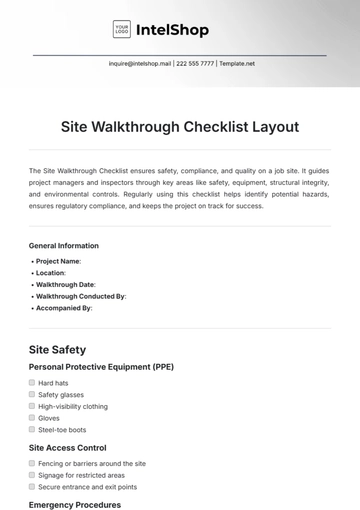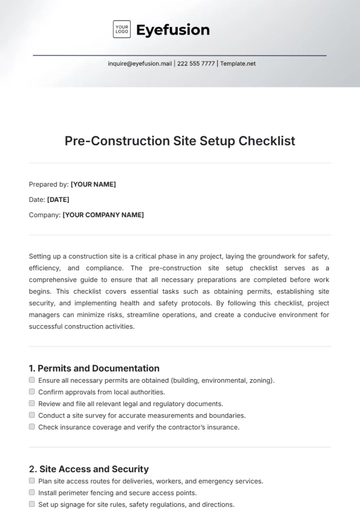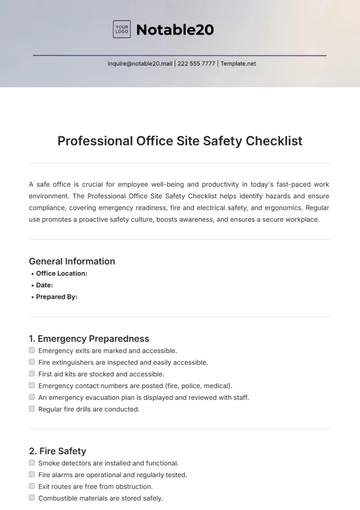Free Farm Site Checklist

Prepared by: [YOUR NAME]
Date: [DATE]
Company: [YOUR COMPANY NAME]
A Farm Site Checklist ensures a thorough evaluation of essential farm aspects like location, soil, infrastructure, and legalities, offering a streamlined guide for successful farming by covering water access, climate, and safety.
1. Site Location and Accessibility
Proximity to Markets: Ensure the farm is close to local markets or distribution centers.
Access Roads: Ensure site roads are well-maintained for easy transport.
Utilities Access: Ensure reliable water, electricity, and internet access.
Emergency Services: Ensure emergency services can easily access the farm.
2. Soil Health and Quality
Soil Type: Identify the soil type and its suitability for crops.
Soil pH Levels: Test soil pH and adjust it if necessary for optimal crop growth.
Fertility: Test soil for nitrogen, phosphorus, and potassium.
Drainage: Ensure proper drainage to prevent waterlogging or erosion.
3. Water Resources
Water Source: Identify available water sources (wells, rivers, irrigation systems).
Water Quality: Test water quality for irrigation and livestock use.
Irrigation System: Ensure there's an efficient irrigation system or plan to install one.
Water Rights: Confirm legal access to water resources.
4. Climate and Weather
Rainfall Patterns: Study rainfall patterns to plan irrigation or drainage accordingly.
Temperature Range: Ensure the site's climate suits the crops or livestock.
Frost/Heat Risk: Assess extreme weather risks like frost, heatwaves, and drought.
Wind Patterns: Consider windbreaks if the site is prone to high winds.
5. Land Size and Layout
Total Acreage: Confirm the total available acreage for farming.
Topography: Check if the land's topography suits the farming activities.
Expansion Potential: Evaluate the potential for future expansion if needed.
Zoning Laws: Check local zoning laws and restrictions on land use.
6. Infrastructure
Fencing: Securely fence the farm, especially for livestock or crop protection.
Storage Facilities: Check storage availability for equipment, produce, and feed.
Housing: Assess the condition of any on-site housing for farmworkers or owners.
Machinery Access: Provide enough space and infrastructure for farm equipment.
7. Pest and Disease Management
Pest History: Investigate the site’s history of pest infestations or crop diseases.
Pest Control Methods: Plan for organic or chemical pest control solutions as needed.
Buffer Zones: Establish buffer zones to limit pest and contaminant exposure.
8. Environmental Sustainability
Conservation Practices: Try cover crops or crop rotation for soil conservation.
Biodiversity: Plant natives and protect local ecosystems to boost biodiversity.
Waste Management: Plan responsible disposal of manure, chemicals, and plastic.
Energy Efficiency: Consider renewable energy (solar, wind) for the farm.
9. Legal and Regulatory Compliance
Permits and Licenses: Obtain all required farming permits, licenses, and registrations.
Environmental Regulations: Follow all environmental regulations.
Farm Insurance: Get farm insurance for crops, equipment, and liability.
Taxation: Understand and comply with agricultural taxation requirements.
10. Safety and Security
Safety Protocols: Set safety protocols for machinery and chemical use.
Fire Safety: Ensure fire prevention tools are available.
Security Systems: Install security systems to prevent crime.
- 100% Customizable, free editor
- Access 1 Million+ Templates, photo’s & graphics
- Download or share as a template
- Click and replace photos, graphics, text, backgrounds
- Resize, crop, AI write & more
- Access advanced editor
You may also like
- Cleaning Checklist
- Daily Checklist
- Travel Checklist
- Self Care Checklist
- Risk Assessment Checklist
- Onboarding Checklist
- Quality Checklist
- Compliance Checklist
- Audit Checklist
- Registry Checklist
- HR Checklist
- Restaurant Checklist
- Checklist Layout
- Creative Checklist
- Sales Checklist
- Construction Checklist
- Task Checklist
- Professional Checklist
- Hotel Checklist
- Employee Checklist
- Moving Checklist
- Marketing Checklist
- Accounting Checklist
- Camping Checklist
- Packing Checklist
- Real Estate Checklist
- Cleaning Checklist Service
- New Employee Checklist
- Food Checklist
- Home Inspection Checklist
- Advertising Checklist
- Event Checklist
- SEO Checklist
- Assessment Checklist
- Inspection Checklist
- Baby Registry Checklist
- Induction Checklist
- Employee Training Checklist
- Medical Checklist
- Safety Checklist
- Site Checklist
- Job Checklist
- Service Checklist
- Nanny Checklist
- Building Checklist
- Work Checklist
- Office Checklist
- Training Checklist
- Website Checklist
- IT and Software Checklist
- Performance Checklist
- Project Checklist
- Startup Checklist
- Education Checklist
- Home Checklist
- School Checklist
- Maintenance Checklist
- Planning Checklist
- Manager Checklist
- Wedding Checklist
- Vehicle Checklist
- Travel Agency Checklist
- Vehicle Inspection Checklist
- Interior Design Checklist
- Backpacking Checklist
- Business Checklist
- Legal Checklist
- Nursing Home Checklist
- Weekly Checklist
- Recruitment Checklist
- Salon Checklist
- Baby Checklist
- Equipment Checklist
- Trade Show Checklist
- Party Checklist
- Hospital Bag Checklist
- Evaluation Checklist
- Agency Checklist
- First Apartment Checklist
- Hiring Checklist
- Opening Checklist
- Small Business Checklist
- Rental Checklist
- College Dorm Checklist
- New Puppy Checklist
- University Checklist
- Building Maintenance Checklist
- Work From Home Checklist
- Student Checklist
- Application Checklist





























